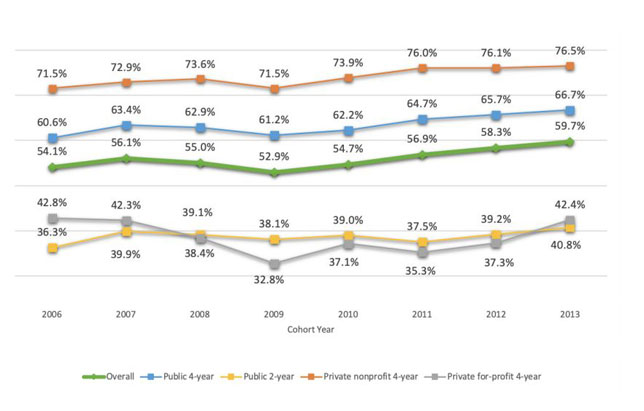College Completion Rates Inch Up Again
- By Dian Schaffhauser
- 12/11/19

Six-year completion rates by institutional type for the cohort starting in 2006 and graduating by 2013. Source: "Completing College: 2019 National Report" from the National Student Clearinghouse Research Center.
Once again, college completion rates this year rose across the board for students attending all types of colleges and universities. The latest analysis by the research arm of the National Student Clearinghouse found that the overall national six-year completion rate for 2.3 million students reached 59.7 percent for those entering school for the first time in fall 2013, up from 58.3 percent for students who entered in 2012.
For students heading into four-year public institutions, the rise in completion was a full percentage point higher than the year before. For those going into two-year public colleges, the increase was 1.6 percentage points. For private nonprofits, the bump was 0.4 points. And for private for-profits, which saw the largest gain in completion among a cohort that was nearly a quarter smaller than the previous year, it was 5.1 points.
The "Completing College 2019 National Report" also offered these findings:
- There was a tiny increase (0.4 percentage points) in the number of "traditional" students (those 20 or younger at the time of enrollment) and a drop in the number of adult learners (those 25 and over) by about 1 point. The former made up 78 percent of the 2013 entering cohort; the latter made up 11.5 percent.
- Younger students were more likely than older students to complete their college careers within six years of starting (64 percent versus 46 percent).
- Also, full-timers among all types of students were nearly twice as likely to finish as part-timers (81 percent compared to 43 percent).
- Among sub-groups, Asian men and women led, with completion rates at 75 and 81 percent, respectively. African American male students gained 1 point in their completion rates (up to 42 percent), and the "stop-out" (or not-enrolled) rate shrank from 42 percent to 38 percent, the "sharpest" drop of all groups. For Hispanic men, with a completion rate of 54 percent, that dropout rate also declined, from 32 percentage points to 28. And Hispanic women showed the greatest completion increase: For delayed-entry (those who waited until they were at least 21 to enroll) and older Hispanic women, the finish rates went from 36 and 35 percent to 40 and 37.5 percent, respectively. As the report noted, "Although continuous gains made by racial/ethnic minorities are promising, the existing completion gaps remain substantial and show little sign of significant shrinkage."
The report added something this year: analysis of college majors. According to the researchers, seven majors accounted for more than six in 10 of the students pursuing four-year degrees for the 2013 cohort:
- Business, management, marketing and related support (18 percent);
- Social sciences (8 percent);
- Engineering (8 percent);
- Biological and biomedical sciences (8 percent);
- Health professions and related clinical sciences (8 percent);
- Psychology (6 percent); and
- Communication, journalism and related programs (6 percent).
For men, the top two fields in public four-year schools were business and management (21 percent) or engineering (15 percent). For women, it was business and management or health professions (with 13 percent of female students declaring for each).
The data also showed that an increasing number of students have earned their undergraduate degree or certificate from the same institution where they first enrolled. As the researchers chose to interpret it, this finding "suggests that institutional efforts to improve retention, progression and success from the start of each student's college career may be increasingly effective in the aggregate, as fewer students transfer to different programs mid-stream."
The complete report and summary report as well as data tables and reports from previous years are openly available on the NSC Research Center website. The Research Center expects to publish state-by-state completion rates for the same cohort in spring 2020.
About the Author
Dian Schaffhauser is a former senior contributing editor for 1105 Media's education publications THE Journal, Campus Technology and Spaces4Learning.